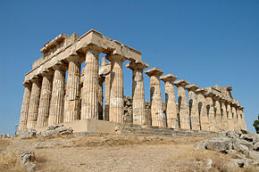SELINUNTE

L’ancienne ville grecque de Selinunte située dans la vallée du fleuve Belice est depuis toujours considérée comme un lieu mythique qui donne à cette terre sa force et ses fruits. Ainsi l’olivier, d’où on extrait une huile onctueuse et parfumée aux reflets dorés, est la fierté des selinuntinais.
La ville de Selinunte a été fondée par des colons grecs de Megara Hyblaea au cours du 7ème siècle avant J.C. sur un promontoire au-dessus de la mer compris entre deux fleuves, dont l'estuaire était alors navigable. Selinunte devint rapidement une cité puissante où le commerce et l'activité artistique étaient florissants. La ville se développa rapidement et atteignit son sommet au V siècle av. J.C. avec une population d’environ 80 000 habitants et était tellement puissante qu’elle battait monnaie. Elle était alors la plus grande ville grecque en Méditerranée. Sa flotte maritime participa à la Guerre du Péloponnèse entre Athènes et Sparte.
Sa fin fut causée par les fréquents accrochages entre elle et la voisine Segesta, qui invoqua l’aide des Carthaginois qui arrivèrent avec leur armée de 100.000 hommes et, selon Diodore le Sicule, assiégèrent la ville pendant neuf jours et la détruisirent complètement. Il y eut 16.000 morts et 5.000 prisonniers et seulement 2.600 habitants réussirent à trouver refuge à Agrigente, leur alliée.
Selinunte vécut pendant deux siècles encore sous la dépendance de Carthagène jusqu’à sa fin provoquée par Rome, qui la détruisit de nouveau à la fin de la première guerre punique. Le site fut abandonné et au Moyen Age il ne fut habité que par des ermites et devint une carrière de pierres pour la population locale. Le parc archéologique de Selinunte est le plus grand d'Europe.

Selinunte was an ancient Greek city on the south-western coast of Sicily in Italy. It was situated between the valleys of the Belice and Modione rivers. The archaeological site contains five temples centered on an acropolis. Of the five temples, only the Temple of Hera, also known as "Temple E", has been re-erected. At its peak before 409 BC the city may have contained up to 30,000 people, excluding slaves.
Selinunte was one of the most important of the Greek colonies in Sicily. It was founded, according to the historian Thucydides, by a colony from the Sicilian city of Megara Hyblaea. The date of its foundation cannot be precisely fixed, but it may be placed about 628 BCE. The name is supposed to have been derived from quantities of wild celery that grew on the spot. For the same reason, they adopted the celery leaf as the symbol on their coins.
Selinunte was the most westerly of the Greek colonies in Sicily, and for this reason they soon came into contact with the Phoenicians of western Sicily and the native Sicilians in the west and northwest of the island. The Phoenicians do not at first seem to have conflicted with them; but as early as 580 BCE the Selinuntines were engaged in hostilities with the non-Greek Elymian people of Segesta, whose territory bordered their own.
The Selinuntines supported the Carthaginians during the great expedition of Hamilcar (480 BCE); they even promised to send a contingent to the Carthaginian army, but this did not arrive until after Hamilcar's defeat at the Battle of Himera.
Diodorus also represents it at the time of the Carthaginian invasion, as having enjoyed a long period of tranquility, and possessing a numerous population. The walls of Selinunte enclosed an area of approximately 100 hectares (250 acres). The archaeological park of Selinunte is the greatest in Europe.






